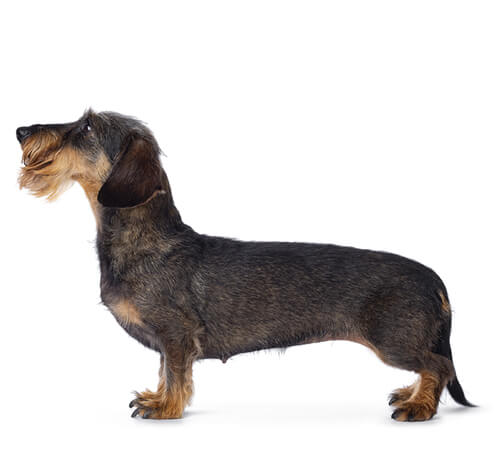
The Dachshund (Wire-Haired) is a medium breed dog on short legs, standing around 35cm tall and about 9-12kg when fully grown. The coat is hard and wiry, forming an attractive moustache, beard and characterful eyebrows. The ears are kept smooth and neat and the whole coat maintained with regular hand stripping or plucking. A wide variety of colours occur but not all are accepted for health reasons – check the breed standard for further details.
The need-to-know
- Dog suitable for owners with some experience
- Some training required
- Enjoys gentle walks
- Enjoys walking an hour a day
- Small dog
- Minimum drool
- Requires grooming once a week
- Non hypoallergenic breed
- Very vocal dog
- Guard dog. Barks and alerts
- May require training to live with other pets
- May require training to live with kids
Personality

The Dachshund (Wire Haired) is a bold, courageous dog with a lively personality and nature. The rugged workman of the Dachshund varieties, the Wire Haired Dachshund still retains the independent and sometimes seemingly obstinate nature of the breed, but is also known for being loyal and good-tempered. They are excellent at tracking a scent outdoors, but equally make an affectionate, people-friendly housedog. It should not come as a surprise that the Dachshund is fond of the sound of his own voice, bearing in mind his ancestral purpose!
History and Origins

Country of Origin: Germany
Dachshunds can be traced back to the 15th Century in Germany, and came to Britain with Prince Albert. Dachshunds short legs allowed them to go to ground after badgers and other burrowing animals, where they would bark loudly to let hunters know where they were underground.
They enjoyed popularity throughout Britain and America during the 19th Century though lost favour during World War I due to their Germanic origins.
Today the Dachshund is again a popular family pet, and the Wire Haired Dachshund is an attractive somewhat shaggy version of the breed.
Nutrition and Feeding

Your dog's diet needs to have the right balance of all the main nutrient groups including a constant supply of fresh water. It's also important to conduct regular body condition scores to ensure you keep your dog in ideal shape and remember to feed him at least twice daily and in accordance with the feeding guidelines of his particular food. Ensuring the Dachshund is not allowed to become overweight is crucial, as excess weight can put pressure on his back.
Exercise

The Dachshund requires at least an hour’s exercise per day. Ensure they have a good recall before letting them off lead as they will be inclined to follow their noses and can get into some small spaces and under fencing!
Other Information

Health and Common Issues
The most common health problem seen in the Dachshund is related to their body shape, making them prone to spinal disorders. Heart disease is also relatively common in the breed. As with many other breeds, various inherited eye disorders can be seen, and breeding dogs should be routinely eye tested.
Space Requirements
Whilst this is not a huge dog, they are long-backed and care should be taken to provide steps and ramps to avoid them jumping on or off furniture. Repeated trips up and down long flights of stairs should be avoided so the Dachshund is better suited to single storey living. A small to medium garden will suit as long as varied walks are provided.
Training Wire-Haired Dachshund
Not a dog ideally suited to those who enjoy training as a hobby, the Dachshund (Long Haired) is capable of learning the basics, including walking on a loose lead, settling quietly and a reasonable level of recall. Typically a friendly dog, they should still be well socialised with people and other animals from an early age.
Best Family Dog Breeds
The Dachshund can make a good family dog with older children or families without children. Their long back is easily damaged and their short stature easily leads children to try to pick them up or treat them as toys which they will not tolerate. While many dogs are traditionally thought of as being good with children, all dogs and children need to be taught to get on with and respect each other, and be safe together. Even so, dogs and young children should never be left alone together and adults should supervise all interactions between them.
Did You Know?
- The Dachshund ended up a member of the hound group due to a mistranslation of their name, ‘hund’ which means ‘dog’ and not specifically ‘hound’. The Dachshund is really a terrier type, bred to go to ground and either flush out quarry or hold it at bay until hunters could dig down to them.